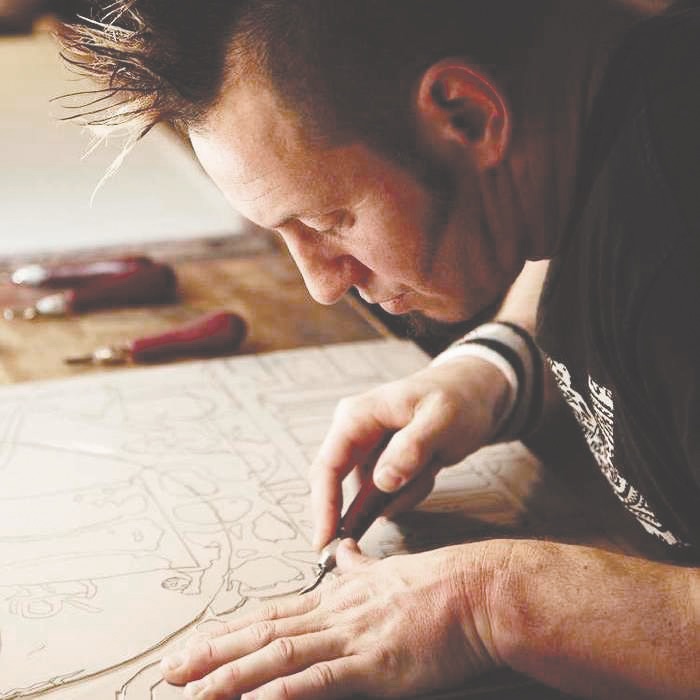 Dave Lefner. Photo from davelefner.com
Dave Lefner. Photo from davelefner.com For many of us, Canter’s Deli stands as a cultural and gustatory icon, beckoning with its pastrami, its hefty helpings of nostalgia and its bustling feeling of being “back East.” For Los Angeles artist Dave Lefner, the deli was a magnet for an entirely different reason: all that neon.
Lefner creates beautiful, soft-hued prints of vintage neon signs, using a reduction linocut technique refined by Picasso. Canter’s was an early inspiration. “When I first started making art 25 years ago, I’d make pilgrimages to Canter’s,” he said. “It’s got everything you want. Great ’50s fonts, a cheerful neon chef. It’s basically a mecca for neon lovers.”
People may think of neon as a nighttime affair, but Lefner photographs signs at dawn and dusk, when shadows are longest. From these photos, he creates a charcoal drawing, which he then flips and rubs onto a block of linoleum to transfer the image.
To make the print, he carves into the linoleum using sharp metal cutters called gouges, rolls on oil-based ink, and prints onto paper using a press. He does a new set of cuts for each color. It’s a painstaking process, labor-intensive and risky; one slip of the linoleum knife and the pending image is ruined.
He discovered the possibilities of linoleum in a book of Picasso’s single-block linocuts from the 1950s. “This changed my world entirely,” he said. “Everyone is familiar with the one-color woodcut, but Picasso was doing these beautiful, complicated, multicolor images with linoleum.”
Lefner’s subject matter is different, but the process is basically the same. Los Angeles’ super sunny skies make the city ideal for scouting neon signs and long shadows. Los Angeles is also home to the nation’s first neon signs. After French chemist George Claude discovered the illuminating power of neon gas in glass in the early 1900s, he sold the first two neon signs in the United States to the L.A.-based Packard car dealership, in 1923.
“You put it on the wall, and people are forced to see the beauty, even of the rust.”— Dave Lefner
By the 1950s, neon signs glowed across the city. Lefner loves the popular typefaces of the ’50s and ’60s, their hope and exuberance. He’s done prints of the Palace Theatre and the Orpheum, both once vaudeville houses, but the majority of neon signs radiate humbler American dreams. “Of course we think of theaters, but mostly it’s these little mom-and-pop stores: liquor, lodging or dry cleaning that fascinates me,” Lefner said. “Neon is so bright. It’s alive. It’s a gas.”
At his living/work loft space in the Brewery Arts complex, one wall is covered with his work. There’s a pale-blue star with the words “Blue Skies” hanging near an aqua print reading “Liquid JOY,” the “Y” a martini glass containing a green olive. The word “DONUTS” is spelled out in one print, each letter in an image of a doughnut. There’s a red-and-white “Star Lite,” the “BEST BEER IN TOWN,” and, of course, the black, white and yellow “Canter’s.”
The work makes you take another look at the visual landscape you drive by — or sit in traffic next to — daily. As Lefner explained, “You put it on the wall, and people are forced to see the beauty, even of the rust.”
It’s also grounding to see someone care so much about hulking hunks of metal and glass that have been standing tall for half a century. In today’s instant-everything culture, many people have such low expectations for objects. People wear “fast fashion” clothes then toss them after three launderings. People adore their cellphones, yet shop for their replacements while still getting to know them. People live in an anxiety-making cycle of shopping and shucking that makes our relationship with personal objects short-lived and superficial. Lefner’s exacting craftsmanship is uplifting itself. He gives his delicate, refined works as long as necessary to get them right. You can see the results in the prints.
He’s currently working on a series about expressing the eternal “yes,” loosely based on an idea in E.M. Forster’s novel “A Room With a View.” He’s also still hunting for new signs and revisiting old ones such as Canter’s. “I have lots of pictures of the place, but I still haven’t captured it exactly the way I want. Maybe another trip — and another print — is needed.”
Skidmore Contemporary Art, Bergamot Station, 2525 Michigan Ave., No. B-4, Santa Monica. Brewery Spring Art Walk, April 7-8.
Wendy Paris is a writer living in Los Angeles and the author of the book “Splitopia.”






















 More news and opinions than at a Shabbat dinner, right in your inbox.
More news and opinions than at a Shabbat dinner, right in your inbox.